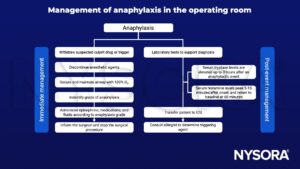Learning objectives
- Recognize signs and symptoms of anaphylaxis
- Define the grade and management of anaphylaxis
Definition and mechanisms
- Anaphylaxis is a severe and potentially life-threatening allergic reaction that develops suddenly and requires immediate medical attention
- The most common anaphylactic reactions are to foods, insect stings, medications, and latex
- Tissues in different parts of the body release histamine and other substances and this causes the airways to tighten
Signs and symptoms
- Sweating
- Rash/hives
- Nausea
- Vomiting or diarrhea
- Wheezing/shortness of breath due to airway constriction or swollen throat
- Fainting with loss of consciousness
- Angioedema
- Hypotension
- Tachycardia
Anaphylaxis grades
| Dermal | Abdominal | Respiratory | Cardiovascular | |
|---|---|---|---|---|
| Grade I | Erythema Urticaria Angioedema | |||
| Grade II | Erythema Urticaria Angioedema | Nausea Cramping | Bronchospasm | Moderate Hypotension Tachycardia |
| Grade III | Erythema Urticaria Angioedema | Nausea Vomiting Diarrhea | Severe Bronchospasm | Life-threatening Hypotension Tachycardia or bradycardia with or without Intraoperative arrhythmias |
| Grade IV | Erythema Urticaria Angioedema | Vomiting Defecation Diarrhea | Respiratory arrest | Peripartum cardiac arrest |
Management
Treatment of anaphylaxis grades
| Intravenous epinephrine | Intravenous fluids (crystalloids) | |
|---|---|---|
| Grade II | Start with 20 μg bolus IV Inadequate response after 2 minutes: escalate to 50 μg and repeat every 2 minutes If no i.v. access: administer 300 μg i.m. | 500 ml rapid bolus Review response Repeat as needed |
| Grade III | 50 μg bolus or 100 μg bolus IV if inadequate response to other vasopressors or bronchodilators Inadequate response at 2 min: escalate to 200 μg and repeat every 2 minutes | 1L rapid bolus Review response Repeat as needed up to 30 ml kg-1 |
| Grade IV | 500 mcg IM/IV over 3 minutes followed by a continuous infusion (4-10 µg/min) Repeat as per ALS guidelines Suggest ECM if systolic <50 mmHg or endtidal CO2 <3 kPa (20 mmHg) | |
| Refractory anaphylaxis: inadequate response >10 min after symptom onset | Double epinephrine dose If response after more than three boluses of epinephrine IV is inadequate, add epinephrine infusion 0.05–0.1 μg/kg/min Hypotension - consider adding: Vasopressin 1–2 IU with or without infusion 2 IU/h Glucagon 1–2 mg (if on beta-adrenergic receptor blockers) Norepinephrine infusion 0.05–0.5 μg/kg/min Suggest ECLS: where available Bronchospasm - add: inhaled or i.v. bronchodilators (β2-agonist such as salbutamol or albuterol) |
Suggested reading
- Garvey LH, Dewachter P, Hepner DL, et al. Management of suspected immediate perioperative allergic reactions: an international overview and consensus recommendations. Br J Anaesth. 2019;123(1):e50-e64.
- Dewachter P, Mouton-Faivre C, Emala CW. Anaphylaxis and anesthesia: controversies and new insights. Anesthesiology. 2009;111(5):1141-1150.
We would love to hear from you. If you should detect any errors, email us at customerservice@nysora.com



